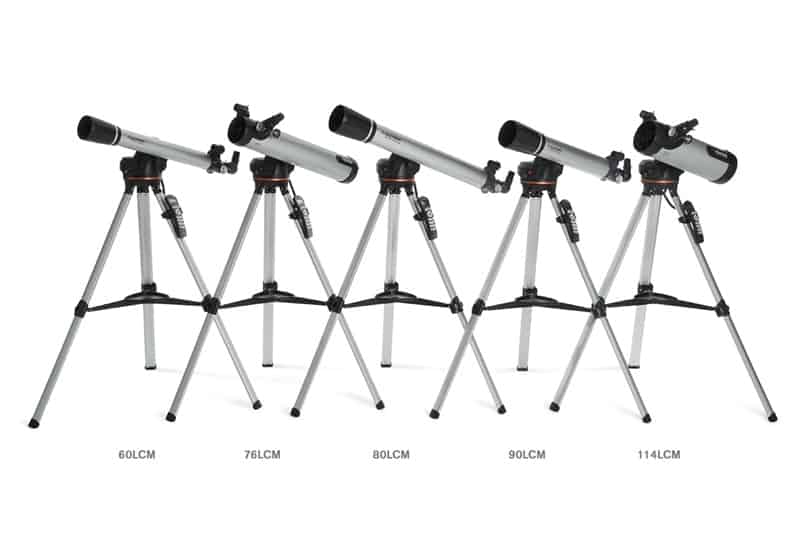
The Celestron LCM range of telescopes is a series of telescopes aimed towards the beginner astronomer that also want some more advances features and is also willing to pay more for such features. There are 5 telescopes in total with the smallest having an aperture of 60mm and the largest 114mm.
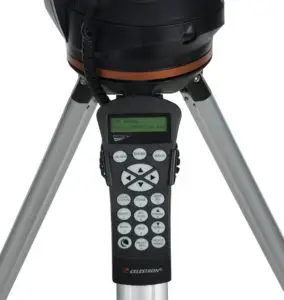
One of the main feature of this range is the SkyAlign technology which enables you to set the computer to navigate automatically to any celestial object from it’s 4000 options database. Basically you don’t have to know any stars or constellations as the telescope will act as you’ve all-knowing guide. Using the SkyAlign is a fairly simple process where you need to center any three bright objects in the telescope’s eyepiece. Once you’ve done this alignment procedure you can select any planet, star, galaxy or nebulae from the database and the telescope will center it in the eyepiece and also track it as it moves across the night sky.
Also it’s important to mention that all telescope have very good optics that deliver clear and bright images. All come with the lightweight computerized mount and an aluminium tripod that has an accessory tray. The remote control is also included in for all the models.
We’ll go though each model from this range starting with the 114LCM and going down till the 60LCM model.
Celestron 114LCM
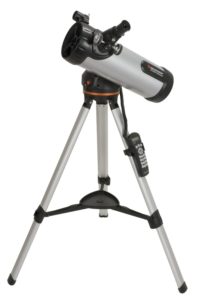
The model with the highest aperture and highest power is the Celestron 114LCM model. It is a newtonian reflector with a 114mm aperture. This is without a doubt the best telescope for star gazing from this particular range.
Click here to check availability and price
This telescope can deliver quality images of the moon and planets but has the ability for viewing deeper objects as well like nebula and star clusters. And finding all these object is an easy process as the telescope will find them for you as the database contains 4000 objects. And speaking of these objects, do keep in mind here that although Celestron really does boast this fact, in reality not all these object are visible with this telescope as it simply does not have the power. Also the database and software can the updated which is always a nice thing as you know that once Celestron brings updates you can upgrade your computerized telescope.
The optical tube contains fully coated optics for the best performances and also has the finderscope attached on it helping with the alignment. It’s not the best finderscope but it does the job. And with this computerized model, you most probably don’t even need a better finderscope. Two eyepieces are included are the 25mm and 9mm which have a magnification power of 40x and 111x respectively.
The tripod is aluminium and works well being sturdy enough when placed on a good flat surface. The tripod also comes with an accessory tray on which you can place all your accessories close at hand.
There are several things that caught my eye in regards to this telescope. At first I believed it was over-priced but after using it I can say that the price is justifiable given the computerized mount. Also you can add a few accessories to this telescope to make even greater. First there is the Celestron accessory kit that adds a few more eyepieces and moon filters, all nicely packed is their own case. Then there is the SkyPortal WiFi module with which you can connect the telescope to your smartphone or tablet and use the SkyPortal app to explore and wirelessly control your telescope. I found this to be very fun. There are other accessories available but I found these two to be the ones that added the most to the 114LCM model.
And as an added bonus you also get the SkyX software which comes sky maps and enhances images but I doubt you’ll be using it as you’ll find the Celestron apps more entertaining.
Overall a very good and fun telescope, the best from this LCM range and I would categorize it as the premium beginner telescope.
Click here to check availability and best price
Pros:
- Premium beginner telescope
- Great optics delivering views of both close and deep night sky objects
- Proprietary computerized tracking system
- Updatable software
- A variety of available accessories
Cons:
- Batteries not included
- Light weight tripod
- Battery life
Full technical specifications:
Optical Design: Newtonian Reflector
Aperture (mm): 114 mm (4.49 in)
Focal Length: 1000 mm (39 in)
Focal Ratio: 8.77
Focal Length of Eyepiece 1 (mm): 25 mm (0.98 in)
Magnification of Eyepiece 1: 40 x
Focal Length of Eyepiece 2 (mm): 9 mm (0.35 in)
Magnification of Eyepiece 2: 111 x
Finderscope: Built-on StarPointer
Mount Type: Motorized Altazimuth
Accessory Tray: No Tool, Quick release
Tripod: Aluminum
Highest Useful Magnification: 269 x
Lowest Useful Magnification: 16 x
Limiting Stellar Magnitude: 12.8
Resolution (Rayleigh): 1.22 arc seconds
Resolution (Dawes): 1.02 arc seconds
Light Gathering Power (Compared to human eye): 265 x
Apparent Field of View: 1.6 °
Linear Field of View (@1000 yds): 84 ft (26 m)
Optical Coatings: Fully-Coated
Slew Speeds: Nine slew speeds
Tracking Rates: Sidereal, Solar and Lunar
Tracking Modes: Alt-Az, EQ North and EQ South
Alignment Procedures: SkyAlign, Auto 2-Star Align, 1-Star Align, 2-Star Align, Solar System Align
Computer Hand Control: Fully Computerized / Flash Upgradeable
Database: 4,000 Object Database
Celestron 90LCM
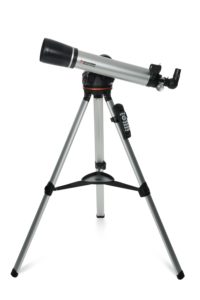
The second telescope from this range in the 90LCM model which unlike the first model is a refractor instead of a newtonian reflector. In fact only the 114LCM and 76LCM are newtonian reflectors the rest being refractors. There is a reason why these models are refractors so let’s look over what’s in the box and what this particular model had to offer.
In the box there is the optical tube, computerized mount with the remote, tripod, two eyepieces and the SkyX software.
The optical tube has great optics like all the models from this range. The finderscope is yet again a StarPointer and the two eyepieces are a 25mm and 9mm one which bring a 26x and 73x magnification respectively. So very similar to what the 114LCM models has. But the 90LCM has an erect images so you can use it for terrestrial viewing as well, as the images will appear right side up.
The tripod seems a bit more sturdy than the 114LCM mainly to due the different size of the telescope but overall it has the same features are does the 114LCM and has the same available accessory options which take it to the next level.
Overall a telescope that is very similar to the first model, but that tends to deliver slightly better and clearer images but with an overall lower magnification power and a telescope that is considerably more lightweight which makes it more portable. Again I have to says that in many ways this is a premium beginner telescope.
Click here to check best price
Pros:
- Great optics with clear and crisp images
- Good for both terrestrial and celestial viewing
- Proprietary computerized tracking system
- Updatable software
- A variety of available accessories
- Lightweight
Cons:
- No batteries included
- Short battery life
Full technical specifications:
Optical Design: Refractor
Aperture (mm): 90 mm (3.54 in)
Focal Length: 660 mm (26 in)
Focal Ratio: 7.33
Focal Length of Eyepiece 1 (mm): 25 mm (0.98 in)
Magnification of Eyepiece: 1 26 x
Focal Length of Eyepiece 2 (mm): 9 mm (0.35 in)
Magnification of Eyepiece 2: 73 x
Finderscope: Built-on StarPointer
Star Diagonal: 1.25 Erect Image
Mount Type: Motorized Altazimuth
Accessory Tray: No Tool, Quick release
Tripod: Aluminum
Highest Useful Magnification: 213 x
Lowest Useful Magnification: 13 x
Limiting Stellar Magnitude: 12.3
Resolution (Rayleigh): 1.55 arc seconds
Resolution (Dawes): 1.29 arc seconds
Light Gathering Power (Compared to human eye): 165 x
Apparent Field of View: 1.6 °
Linear Field of View (@1000 yds): 84 ft (26 m)
Optical Coatings: Fully-Coated
Slew Speeds: Nine slew speeds
Tracking Rates: Sidereal, Solar and Lunar
Tracking Modes: Alt-Az, EQ North and EQ South
Alignment Procedures: SkyAlign, Auto 2-Star Align, 1-Star Align, 2-Star Align, Solar System Align
Computer Hand Control: Fully Computerized / Flash Upgradeable
Database: 4,000 Object Database
Celestron 80LCM
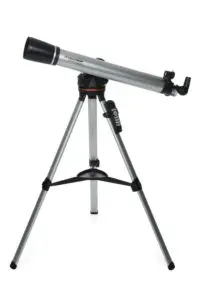
The third telescope from this range in terms of aperture is the Celestron 80LCM which has a 80mm aperture and a refractor design. In many ways this models is similar to the 90LCM but not identical as it has it’s strong and weak points.
The box contains the optical tube, two eyepieces, tripod, remote and a copy of the SkyX software. So pretty much the exact same things as the previous two models had.
Again the optics of the telescope are of high quality along with the two eyepieces of 25mm and 9mm which deliver a magnification power of 36x and 100x respectively. The finderscope is a built-on StarPointer which does the job, but as mentioned before it’s not an important factor for these telescopes as once you have aligned the telescope the computerized mount does all the hard work. Similar to the 90LCM model this telescope is suited for terrestrial viewing as well as the images are erect meaning their are right side up.
Most of the things I’ve mentioned with the previous models also stand here. The accessories are a great add to purchase with this telescope as it makes the entire experience much more fun and this is very much a premium beginner telescope. What makes this model different from the previous two and in particular the 90LCM is the 80mm aperture and the 11 focal ratio which makes this telescope better suited towards viewing the moon and planets as it deliver clearer and crisper images of these objects. The deeper sky images are of good quality as well as it does have the required power but the best images obtained with this telescope are the ones of the moon and planets and other “closer” celestial objects and you should take that in consideration when purchasing this model in particular.
Click here to see best available price and stock availability
Pros:
- Great optics
- Computerized mount with tracking system
- Good for both terrestrial and celestial viewing
- Upgradable software with already has a 4000 object database
- A multitude of available accessories
- Lightweight model
Cons:
- No batteries
- Short battery life
- Lightweight tripod
With the 80 mm aperture and a
Full technical specifications:
Optical Design: Refractor
Aperture (mm): 80 mm (3.15 in)
Focal Length: 900 mm (35 in)
Focal Ratio: 11
Focal Length of Eyepiece 1 (mm): 25 mm (0.98 in)
Magnification of Eyepiece 1: 36 x
Focal Length of Eyepiece 2 (mm): 9 mm (0.35 in)
Magnification of Eyepiece 2: 100 x
Finderscope: Built-on StarPointer
Star Diagonal: 1.25 Erect Image
Mount Type: Motorized Altazimuth
Accessory Tray: No Tool, Quick release
Tripod: Aluminum
Highest Useful Magnification: 189 x
Lowest Useful Magnification: 11 x
Limiting Stellar Magnitude: 12
Resolution (Rayleigh): 1.74 arc seconds
Resolution (Dawes): 1.45 arc seconds
Light Gathering Power (Compared to human eye): 131 x
Apparent Field of View: 1.6 °
Linear Field of View (@1000 yds): 84 ft (26 m)
Optical Coatings: Fully-Coated
Slew Speeds: Nine slew speeds
Tracking Rates: Sidereal, Solar and Lunar
Tracking Modes: Alt-Az, EQ North and EQ South
Alignment Procedures: SkyAlign, Auto 2-Star Align, 1-Star Align, 2-Star Align, Solar System Align
Computer Hand Control: Fully Computerized / Flash Upgradeable
Database: 4,000 Object Database
Celestron 76LCM
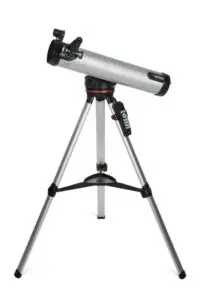
The fourth model in this range by the order of aperture size is the 76LCM model which is the second model that is a newtonian reflector like the 114LCM.
In many ways this is the middle telescope of this range being able to deliver a bit of each of the previous telescopes. The box comes with the same things that the previous models have and that is the optical tube, computerized mount, tripod, two eyepieces and a copy of the SkyX software.
As with all the models the setup is done in no-time ans is easy and straight forward.
Again it’s important to mention that the optics are of good quality as well as the two included eyepieces. As with all these telescopes the included eyepieces are a 9mm and a 25mm one, but for this telescope having a magnification power of 28x for the 25mm one and 78x for the 9mm one.
This telescope is a compromise between better the best images of the “closer” celestial objects like the moon and planets and the deeper sky objects like nebulae, but for me it represent a real question mark as to whether this compromise is a good one for the beginner astronomer. I feel that Celestron has tried to catch two rabbits here and ended up with none. Having said this I still feel this is in many respects a good telescope but the price point does not offer that much value. Even if there is the computerized mount I feel that the price is not justifiable overall. For slightly higher price point the previous models are much better. However for a considerable discount I would seriously consider this telescope.
Click here to check latest price
Pros:
- Good quality optics
- Computerized mount with tracking system
- Upgradeble software
Cons:
- Batteries not included
- Short battery life
- Not the best value/price ratio
Full technical specifications:
Optical Design: Newtonian Reflector
Aperture (mm): 76 mm (2.99 in)
Focal Length: 700 mm (28 in)
Focal Ratio: 9.21
Focal Length of Eyepiece 1 (mm): 25 mm (0.98 in)
Magnification of Eyepiece 1: 28 x
Focal Length of Eyepiece 2 (mm): 9 mm (0.35 in)
Magnification of Eyepiece 2: 78 x
Finderscope: Built-on StarPointer
Mount Type: Motorized Altazimuth
Accessory Tray: No Tool, Quick release
Tripod: Aluminum
Highest Useful Magnification: 180 x
Lowest Useful Magnification: 11 x
Limiting Stellar Magnitude: 11.9
Resolution (Rayleigh): 1.83 arc seconds
Resolution (Dawes): 1.53 arc seconds
Light Gathering Power (Compared to human eye): 118 x
Apparent Field of View: 1.5 °
Linear Field of View (@1000 yds): 79 ft (24 m)
Optical Coatings: Fully-Coated
Slew Speeds: Nine slew speeds
Tracking Rates: Sidereal, Solar and Lunar
Tracking Modes: Alt-Az, EQ North and EQ South
Alignment Procedures: SkyAlign, Auto 2-Star Align, 1-Star Align, 2-Star Align, Solar System Align
Computer Hand Control: Fully Computerized / Flash Upgradeable
Database: 4,000 Object Database
Celestron 60LCM
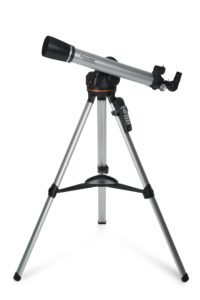
The Celestron 60LCM model is the weakest on in terms of overall power having a 60mm aperture.
Click here to check latest price
This is a refrector model similar to the 80LCM and 90LCM models. But unlike those two models, despite having good optics, the overall power of the telescope is too low which makes the computerized mount not able to deliver the best results. You can still get fantastic images of the moon and planets but considering the price point you have to reach the conclusion that for this price you could get a higher aperture telescope that does not have the computerized mount or you can simply make a slightly higher price commitment and choose one of the other models from this series and by doing so you will have a much better price/value ratio.
Pros:
- Quality optics
- Computerized mount with tracking system
- Upgradeable software
- Good for both terrestrial and celestial viewing
Cons:
- No batteries included
- Not the best value/price ratio
Full technical specifications:
Optical Design: Refractor
Aperture (mm): 60 mm (2.36 in)
Focal Length: 700 mm (28 in)
Focal Ratio: 12
Focal Length of Eyepiece 1 (mm): 25 mm (0.98 in)
Magnification of Eyepiece 1: 28 x
Focal Length of Eyepiece 2 (mm): 9 mm (0.35 in)
Magnification of Eyepiece 2: 78 x
Finderscope: Built-on StarPointer
Star Diagonal: 1.25 Erect Image
Mount Type: Motorized Altazimuth
Accessory Tray: No Tool, Quick release
Tripod: Aluminum
Highest Useful Magnification: 142 x
Lowest Useful Magnification: 8.57 x
Limiting Stellar Magnitude: 11.4
Resolution (Rayleigh): 2.32 arc seconds
Resolution (Dawes): 1.93 arc seconds
Light Gathering Power (Compared to human eye): 73 x
Apparent Field of View: 1.6 °
Linear Field of View (@1000 yds): 84 ft (26 m)
Optical Coatings: Fully-Coated
Slew Speeds: Nine slew speeds
Tracking Rates: Sidereal, Solar and Lunar
Tracking Modes: Alt-Az, EQ North and EQ South
Alignment Procedures: SkyAlign, Auto 2-Star Align, 1-Star Align, 2-Star Align, Solar System Align
Computer Hand Control: Fully Computerized / Flash Upgradeable
Database: 4,000 Object Database
